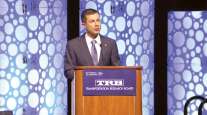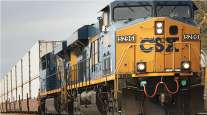Staff Reporter
Indiana River Port Featured in White House Rural Infrastructure Tour

[Stay on top of transportation news: Get TTNews in your inbox.]
The Department of Transportation has released $44 billion for rural infrastructure, an announcement that reinforced a White House commitment and aligned with a visit by Transportation Secretary Pete Buttigieg to a small Indiana river port.
Over the next five years, DOT will make these funds available under the $1 trillion Infrastructure Investment and Jobs Act, commonly called the Bipartisan Infrastructure Law, to help rural communities rebuild and modernize roads, bridges, transit, airports and ports.
Buttigieg on April 13 addressed local and state officials in Tell City, Ind. — named after Swiss hero William Tell — where DOT awarded a $1.6 million port infrastructure grant to add a pier to improve barge-to-truck capacity. The port primarily is used to move pig iron along the Ohio River at a foundry that employs 1,000 workers and produces car parts.
Tell City River Port, located along the Ohio River, also specializes in the handling, storing and offloading of bulk materials such as coke, coal and woodchips from river barges. It is served by several barge companies, and can receive barge traffic from the headwaters of the Ohio as well as Great Lakes and Gulf of Mexico ports.
Currently, rising and falling water levels render barges unable to load and unload, but a new pier design will remove these obstacles.
After the port improvements are completed, it is estimated factory productivity could soar up to 60%.
“Those benefits are going to ripple out across the community,” Buttigieg said, and help improve the supply chain for the automotive industry.
According to DOT, 13% of rural roads and 10% of mostly countryside off-system bridges are in poor condition. It also says 45% of all roadway fatalities happen on rural roads — twice as high as urban road rates — despite only 19% of the U.S. population living in rural areas.
“There are over 3,000 closed bridges in rural areas and another 50,000 where you’ve got weight restrictions due to their condition,” Buttigieg said. “When a bridge is closed in a rural area and you have a load limit that you can’t cross, that means that the length of the average detour is going to be a lot more severe than in an area that’s concentrated with a lot of alternatives.”
Buttigieg said rural communities have been under-recognized and under-resourced for years.
“It’s often said there’s no such thing as a Republican bridge or a Democratic road and that’s exactly right. We’re going to fund projects that make life better and make our country stronger in every community where there’s a need and in every community where there’s an opportunity,” he added.
Rural communities are vital to the life of our nation, and as we saw here in Tell City, one small port can have a big impact. Materials handled here go into equipment and economic activity that can benefit people a thousand miles away, creating jobs and value for all. pic.twitter.com/7HK8AZk0hD — Secretary Pete Buttigieg (@SecretaryPete) April 13, 2022
Mike Smith, commissioner of the Indiana Department of Transportation, noted during the event that Indiana is a leader in freight movement; it’s the No. 1 state for highway pass-through mileage and No. 3 for freight rail miles. It has the second-largest cargo hub in the U.S. and a thriving inland water port network.
“Indiana has been known as the crossroads of America for nearly a century now,” Smith said. “We earn that motto thanks in large part to our central location in the country. Businesses can expect 80% of the country can be reached within a one-day trip.”
He said INDOT understands at a state level the importance of investing in local communities, and looks forward to working with the USDOT team to deliver infrastructure projects to local partners.
Buttigieg’s Indiana visit was part of President Joe Biden’s Building a Better American Rural Infrastructure Tour, in which top transportation officials will travel across the country to highlight the billions of dollars in funding for transportation for rural and tribal communities.
Another goal of the tour is to provide opportunities for senior DOT staff to hear directly from local elected, community and business leaders about local transportation priorities.
Want more news? Listen to today's daily briefing below or go here for more info:




